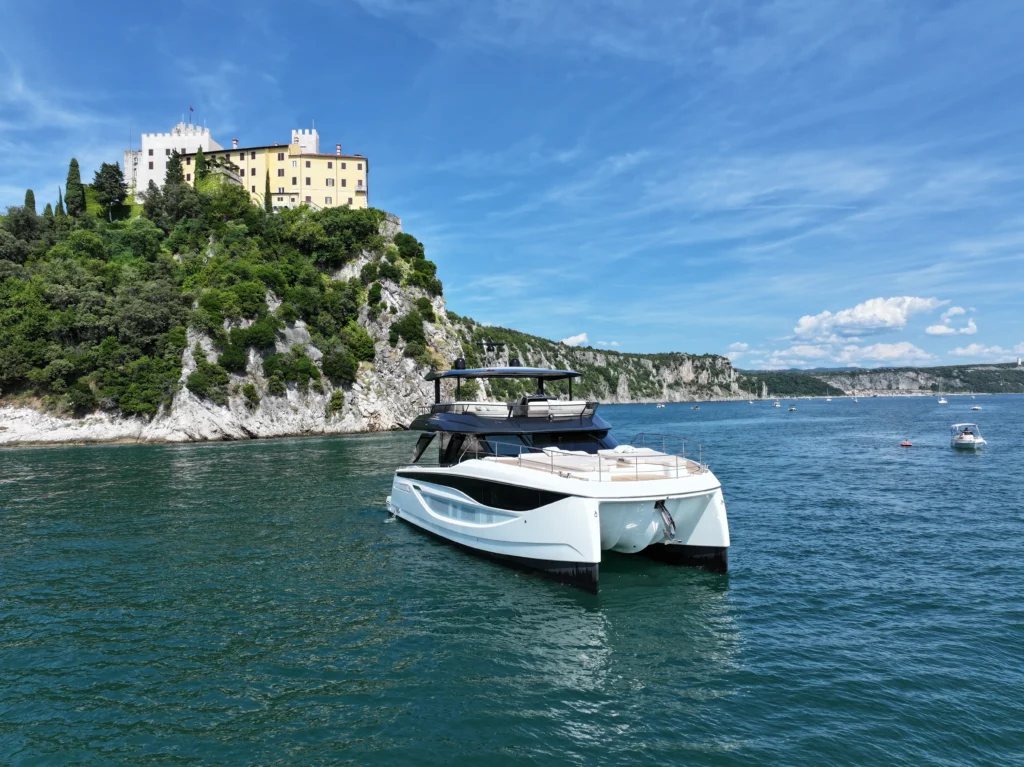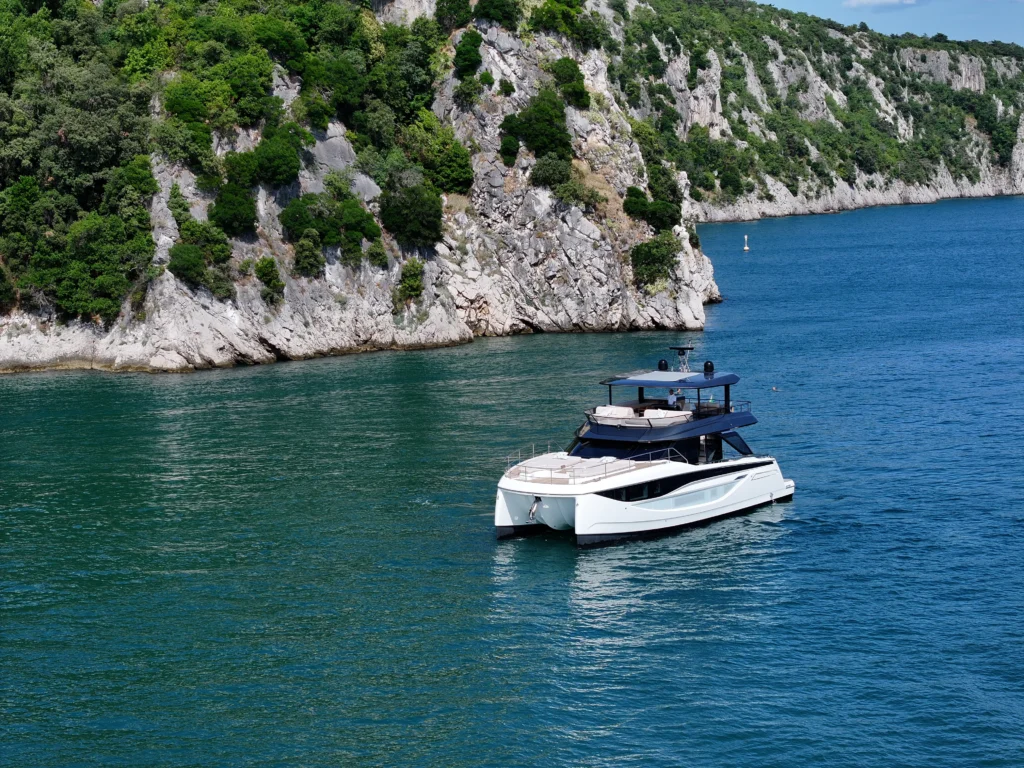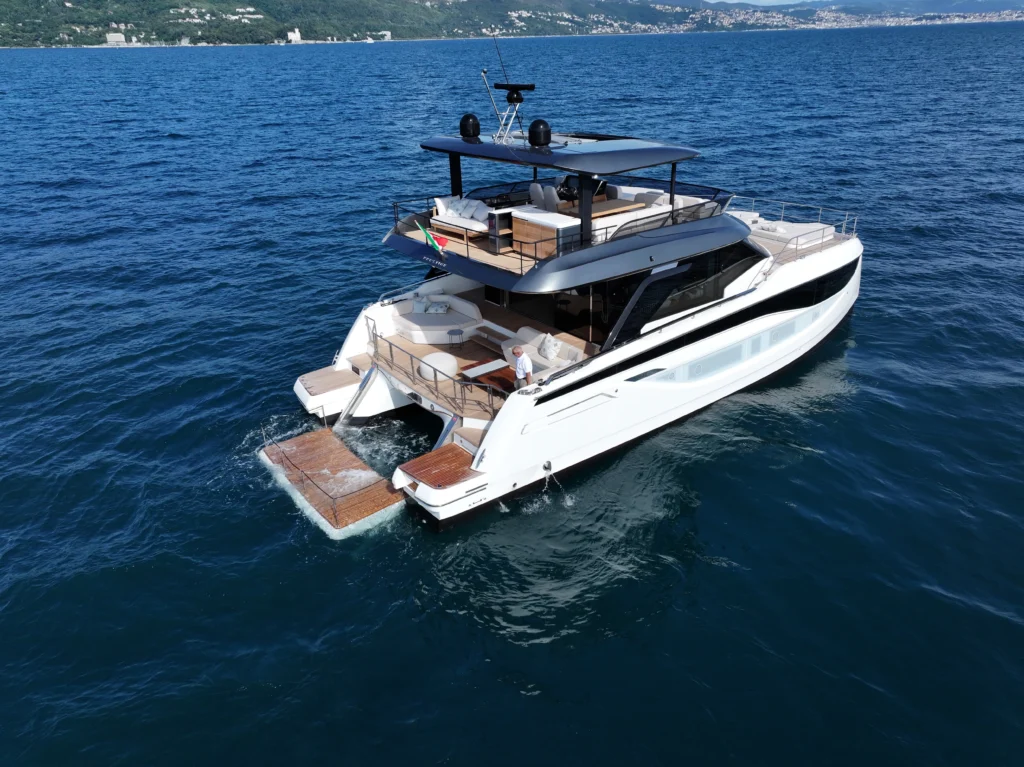Prestige Yachts M7
As the undisputed world leader in motoryachts, Prestige Yachts owes its particularly enviable growth to bold strategic choices, but also to a genuine ability to listen to market demands. All qualities that have made the difference in transforming a simple model name into an iconic brand. In 2022, the manufacturer surprised once again with the launch of its first motor catamaran, the M48. This innovative first model was followed in 2023 by the M8, then this year by the M7, which we were able to discover exclusively…
At the end of the 1980s – the decade of “always more” – luxury cars and eye-catching yachts were the order of the day, and it was against this backdrop that Jeanneau launched the Prestige 41. Unfamiliar with the world of yachting, the shipyard’s managers turned to Italy with designer Vittorio Garroni. Building on this initial success, Jeanneau collaborated with Ferretti to create the Yarding Yachts brand. It was much later, in 1997, that Prestige returned to the forefront, becoming a complete range. It was the start of a great success story, since in 2009, on its twentieth anniversary, Prestige had already sold 2,500 units and, above all, had become a brand. Today, more than 5,000 motoryachts bear the Prestige name, and the brand is supported by three monohull ranges – F-Line, S-Line and X-Line – and 1,200 employees.
M-Line range: the multihull challenge
But let’s go back a bit: in 2022, Prestige presents its M48, its first motor catamaran. After thirty-three years of exclusively monohull production, it’s not hard to imagine that the marketing approach had been carefully thought through. Starting from the premise that the brand’s customers were demanding ever greater comfort and ease, and that this demand had reached its peak in terms of feasibility with the latest X-Line range, the Prestige Yachts teams decided, in agreement with the Beneteau group, to enter the powercats market. However, there was no question of “losing” the brand’s loyal customers; the main aim was to offer a Prestige, but with two hulls, as part of an eco-responsible approach. For the same speed and displacement, a catamaran hull consumes 40% less fuel than a monohull hull. The manufacturer even goes a step further, choosing to offer a model whose maximum speed is deliberately limited to 20 knots, whereas most competitors on the market go for 25… Andrea Garroni, who has been responsible for the design of all Prestige models since the famous 41, was naturally asked to design the M48. For the new M-Line range, the challenge was to imagine new motor multihulls, while preserving the brand’s identity. The architectural decision was to design hulls exclusively for motor propulsion, to create a unit that was narrower than sailing catamarans, but taller. In terms of the Prestige lineage, the result is very convincing. As for the hull, naval architect Philippe Briand was chosen. The M48 got off to an excellent commercial start at the Cannes Yachting Festival 2022: of the twenty or so sales signed at the show, just over half were M48s! Eventually, according to Prestige Yachts management forecasts, the M range should account for 40% of the brand’s total sales. Two years ago, Prestige launched a second model, the M8. M for multihull, of course, and 8 for “80-foot monohull equivalent”. This terminology, while somewhat isolating the M48, is already familiar to the Beneteau Group – and especially to Fountaine Pajot’s MY range. In this much larger size – we’re talking 65 feet here – the brand offers high-class features with the undisguised aim of entering the world of yachting. The builder, who entrusted the hull to Marc Lombard Yacht Design, now intends to get even more serious with its new flagship yacht.
Prestige M7: a third model
This new model, which logically falls between the M48 and M8, was announced at the boot Düsseldorf trade show in January 2025. Six months later, the manufacturer unveiled the third model in the M range at a preview event in Monfalcone, Italy, just a stone’s throw from the yard where it was built. Seen from the quayside, the M7 is an impressive sight. Compared to the two previous models, the Garroni Design team has not contented itself with a tempting copy-and-paste job; in fact, there are a number of original touches, such as the thicker bulwark forward, the more pronounced inverted deckhead in the cockpit, the semi-transparent deckhouse pillar detached from the superstructure, and a more assertive choice of colors. All we have to do is step aboard to appreciate the generous space offered and the exceptional level of finish dictated by Prestige, which translates into a selection of top-quality materials – an elegant marriage of luxury and good taste. Once again, the multihull configuration works wonders, as the M7’s comfort levels are comparable to those of a 75-foot monohull yacht, with 200 m 2 of living space, including 112 m 2 on the main deck alone.
Three distinct zones can be distinguished on board the M7: the foredeck, with its sunbathing areas and saloon; the gangways, secured by a full rail around the nacelle; and finally the cockpit, a large, deliberately lowered and widened area. Like the flybridge, which we’ll describe in more detail later, the cockpit features a number of layouts, including a central table or one offset to starboard, and a vast salon. This already exceptional cockpit is complemented by an immense terrace for enjoying the sea with family or friends: the central hydraulic platform fits perfectly between the two aft skirts to exploit the full width available. This veritable beach club allows you to store your tender while underway, and then enjoy the pleasures of the anchorage to the full. The inverted staircase leads to the flybridge. The M7’s designers decided to place imposing solariums just behind the large, wrap-around windshield. The occupants of these spacious bench seats benefit from both the sun, since the T-Top with sunroof is slightly recessed, and perfect protection from the wind. The manufacturer also offers a Skylounge option with enclosed flybridge. The 35 m2 of available space can be arranged in a variety of configurations.
Full of innovations
On board the M7, there are two particularly attractive new features: the port-side companionway door leads directly to the flybridge, but also to the flybridge staircase, which is presented “upside down” compared to conventional configurations. This layout makes the flybridge accessible from both inside and outside without losing space, while protecting the staircase from the elements. The generously glazed nacelle has a large central entrance. To starboard, a large dining table can take the place of a streamlined lounge. On the port bow, a vast U-shaped galley. Opposite, you can opt for a bar or a second helm station, seated or standing. The M7’s nacelle is sufficiently elevated for the lower-deck cabins to take advantage of most of the tunnel between the two hulls. In all, the surface area dedicated to the night space reaches 53 m 2.
The spectacular owner’s suite is located forward: particularly bright, it offers 20 m 2 of living space, with a large bathroom, storage space and a vast office. The 10 m 2 VIP cabin is located on the port side, in front of the crew quarters. Opposite, two other 6 and 8 m2 cabins have been installed on either side of the companionway. Engines! The use of the plural is not unheard of when maneuvering in port: having two engines whose propulsion can be reversed is notably appreciable. It’s possible to master very precise rotations, even without modern navigation aids, which are of course available at the helm. At the helm, you have the sensation of maneuvering a much lighter boat, as reactions are so immediate and straightforward. Like the M48 and M8, our luxurious powercat is very fuel-efficient. During our tests, the two 550 hp Volvo D8 engines ensured a top speed of 20 kts, in line with the M-Line philosophy; the manufacturer’s recommended cruising speed is 17 kts. A respectable cruising range of 1,330 miles was achieved at 8 kts. At this speed, fuel consumption is limited to just 2 liters per nautical mile, which is surprisingly low for such a comfortable yacht. For those who want even more range, Prestige offers a Long Pack Range with larger fuel tanks – increasing fuel capacity from 2,900 to 3,400 liters. The hulls, again by Marc Lombard Yacht Design, have been optimized for seaworthy behavior. Both hulls absorb roll immediately and naturally – a definite advantage over monohull configurations requiring stabilizers. In terms of seaworthiness, the M7 can also count on its slender bows at the waterline, highly accomplished weight centering and high nacelle height. The sailing experience is calmer and less humid, allowing you to make the most of areas that are usually more exposed on monohulls, such as the flybridge and foredeck.
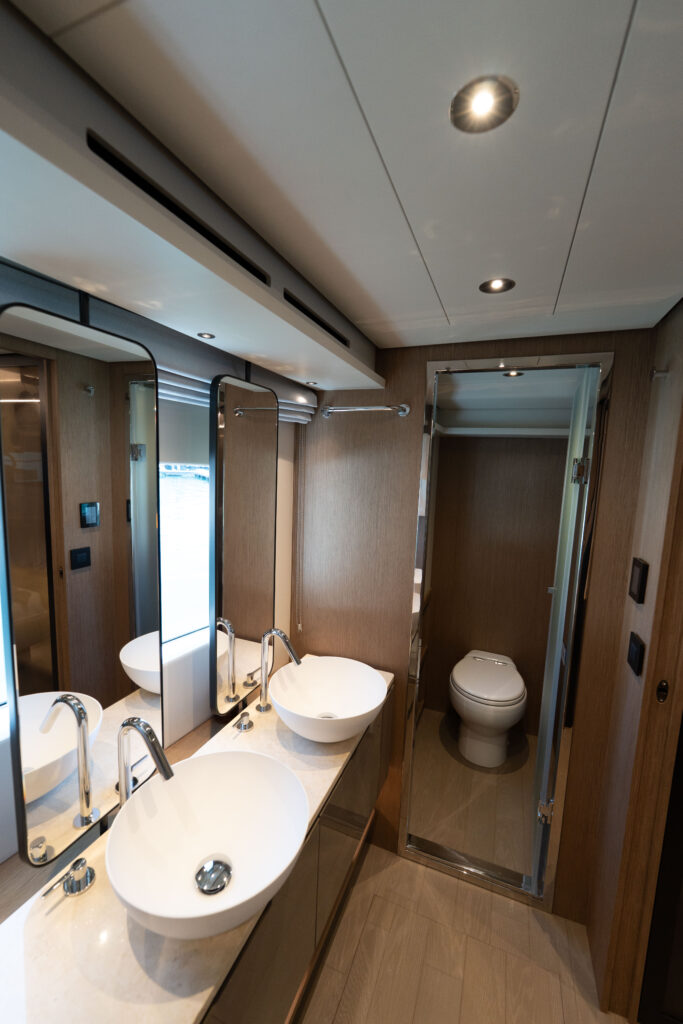
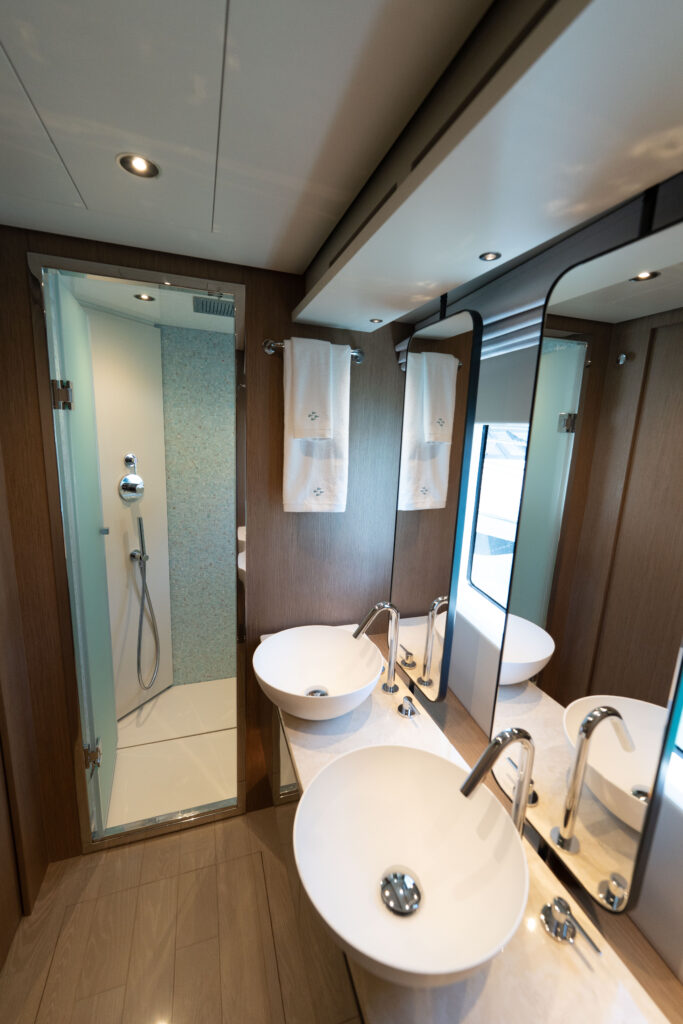
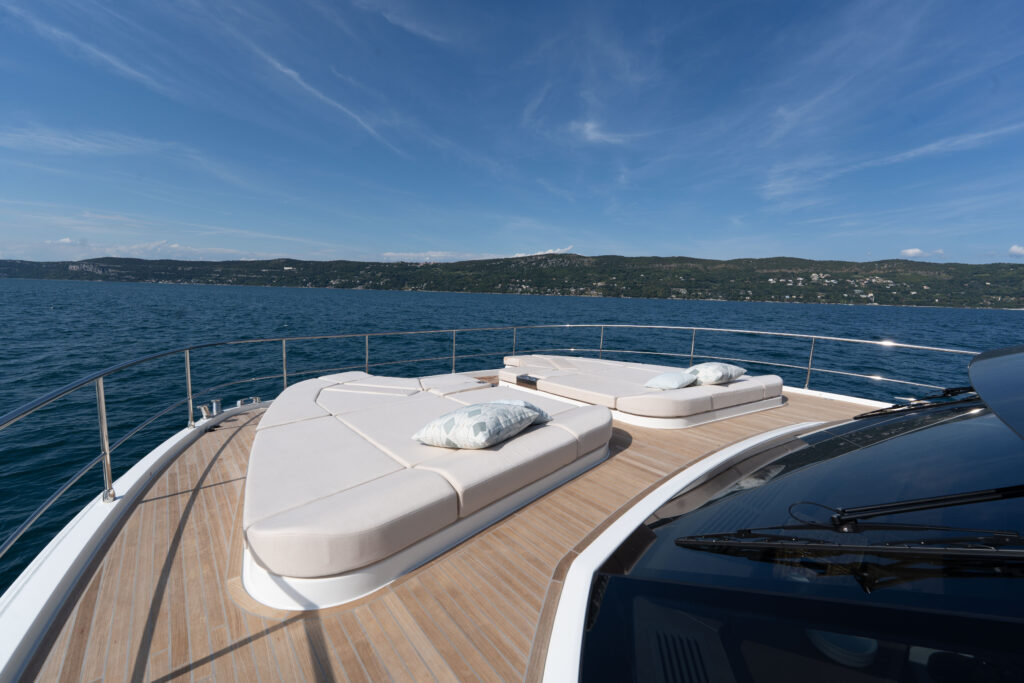
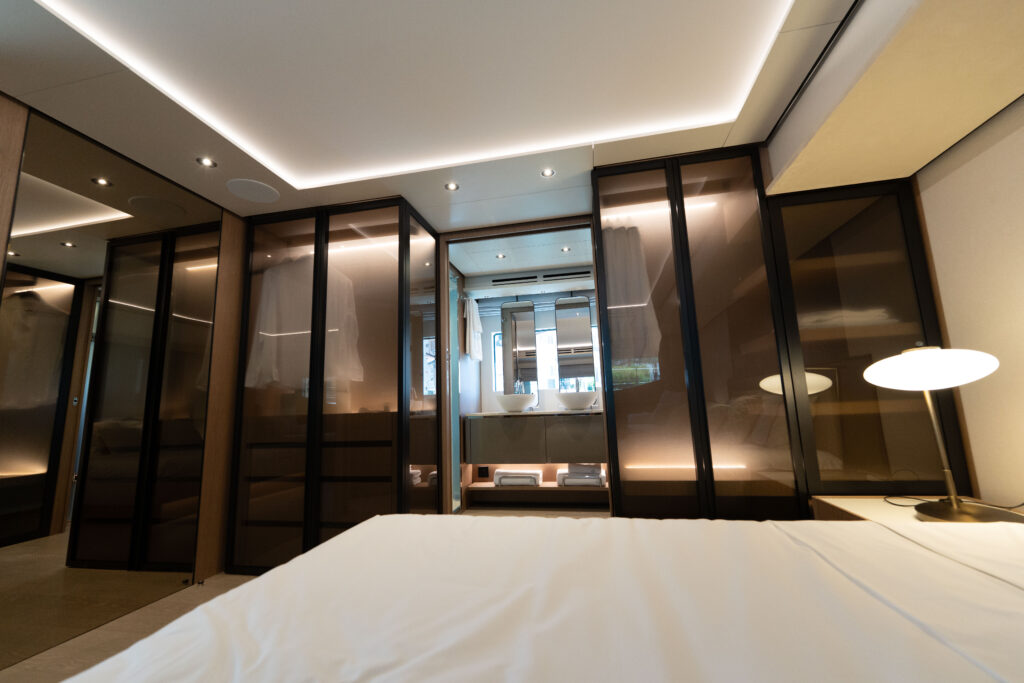
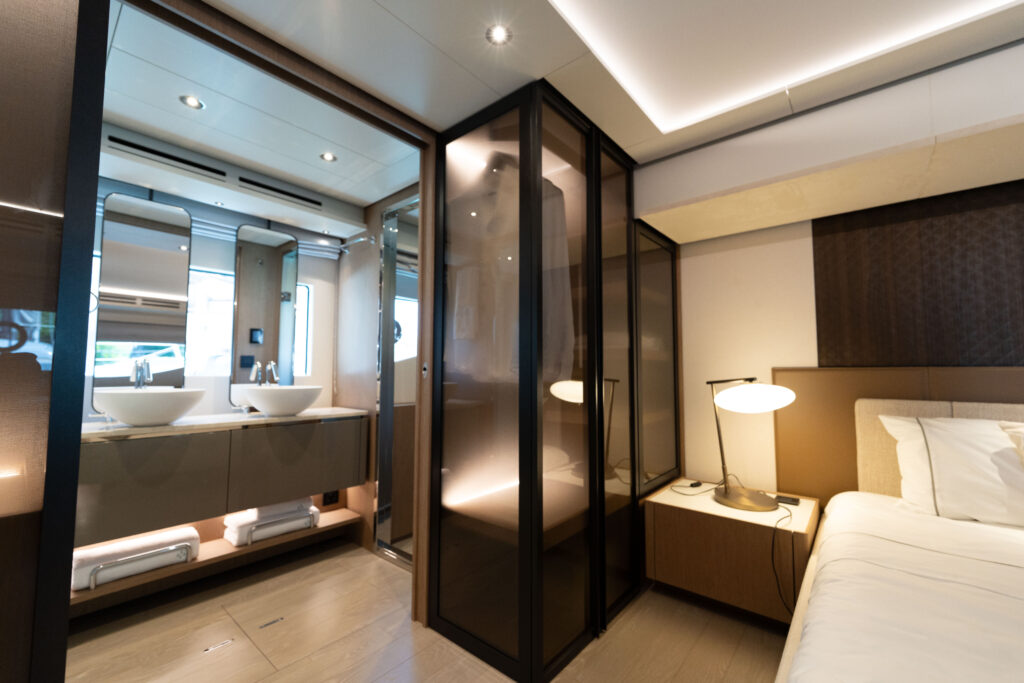
As an option, you can opt for the Silent Mode Package, which enables you to have zero carbon emissions for twelve hours, without having to do without the usual comforts (air conditioning, power supply for the entire cold park, lighting, etc.). The package includes 16 m2 of solar panels (equivalent to 2.6 kWp) and a bank of lithium batteries. With this M7, Prestige continues the semi-custom approach already validated with the M8, offering a wide range of configurations, layouts and options to ensure that each unit meets the exact requirements of its owner.
Beneteau’s Monfalcone plant: a privileged Mediterranean location. The construction of large yachts over fifty feet in length – especially multihulls – poses major transport problems when the shipyard is not located near the sea or a navigable river. This is why industrial sites with their “feet in the water” are particularly coveted by builders… The Beneteau Group has made no mistake in investing in the Monfalcone factory, with its 45,000 m2 of production space facing the Adriatic Sea. It’s here, just outside Trieste in Italy, that all the major Prestige models are built, and where the Neo refit center is located. During our visit, we discovered a workshop for the production of composite parts, assembly lines, a state-of-the-art paint booth, a vast open space and even a marina. 200 employees work on this site.
Builder : Prestige Yachts
Architect : Marc Lombard Yacht Design
Design : Garroni Design
Length overall: 17.80 m
Hull length: 17.60 m
Beam : 7.50 m
Engines: 2 x Volvo D8 550 hp
Top speed: 20 kts
Cruising speed: 17 kts
Fuel : 2’900 L
Water : 760 L


